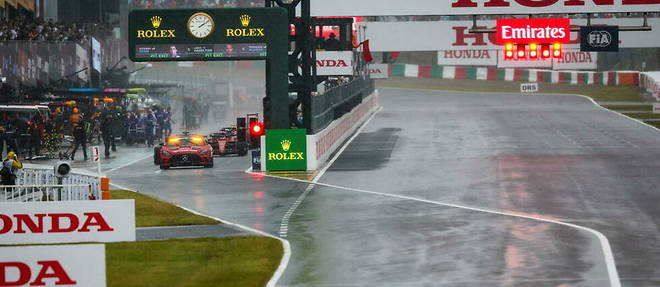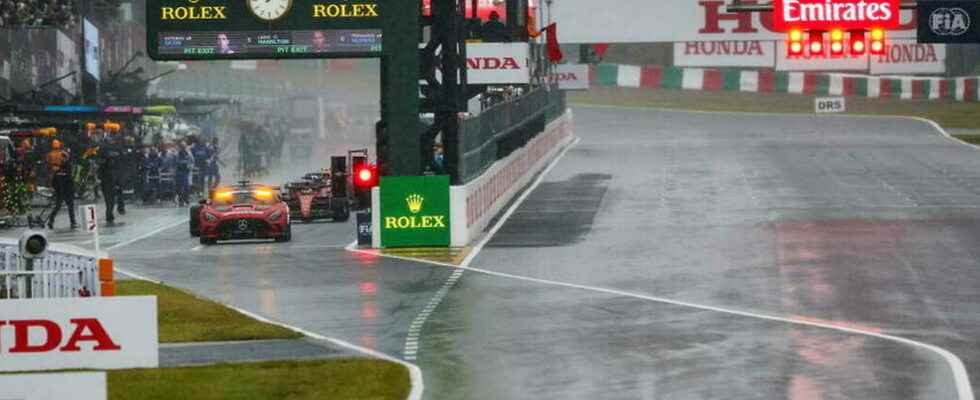In general confusion, Verstappen became F1 world champion. In the midst of a renaissance, the discipline has nevertheless made a fool of itself.
By Florent Barraco

© FLORENT GOODEN / DPPI / DPPI via AFP
Published on
– Modified
Link copied
Copy link
MEven in the greatest successes, there is a “but”. We have rightly praised the successful revolution of Formula 1. New charismatic drivers, modernized rules of the game, suspense… The discipline has experienced a real renaissance since its takeover by the American giant Liberty Media. But, there is a but “. After the simulacrum of Grand Prix at Spa in Belgium last year, Formula 1 experienced this Sunday in Japan a new episode of: “Let’s drive in the rain”. Or rather: let’s not drive. A light, but regular then heavy rain fell on the legendary Suzuka circuit. Unlike Spa, the start was indeed given, but the “race” was interrupted after Carlos Sainz’s accident. For two hours, the single-seaters were stopped in the pit lane and there was a wait and a wait. The rain calmed down, then increased again, then calmed down… 120 minutes later, the start was launched for a forty-minute grand prix with an incomprehensible conclusion: all the points were awarded, allowing Verstappen to be crowned world champion for the second time.
The rain, the salt of F1
This new prank illustrates the reluctance of instances and pilots. The weather conditions were difficult, but not impossible. Especially given the past. How many grands prix have been held with much more rain? Our memory is filled with epic races where the circuits were waterlogged, such as at Spa in 1998, Monaco in 1982 or 1996 or the legendary torrential rains in Brazil.
It is on these occasions that the greatest drivers shine, where the differences between engines and single-seaters are erased, where the history of F1 is written. Ayrton Senna, Michael Schumacher, Fernando Alonso or Jenson Button showed all their talent and danced in the rain. The artists reveal themselves on a wet track. Disappointments too: in 1998, Michael Schumacher lost the championship by hitting David Coulthard; Vettel sees his good run come to an end and his confidence damaged at Hockenheim in 2018… Let’s not talk about the incredible comebacks and the unexpected winners. In short, the rain is the salt of F1.
READ ALSOFormula 1: “We can expect anything, this season is going to be crazy”
After his retirement, the Thai Alex Albon had this very symbolic statement: “These are the worst conditions I have experienced in my career. Of course we want to run, but at what cost? This is a major change for this “Netflix generation”: no risk, long live the precautionary principle. Driving in the rain is perhaps the essence of the job: you manage your single-seater, you assess the risks to be taken, you play with the zones. This is no longer the mindset of these speed giants.
Of course, the question of safety remains paramount, especially at Suzuka where Jules Bianchi had his fatal accident eight years ago, succumbing to his injuries after months of coma in July 2015. The Frenchman had hit a crane – a memory lively and shocking when we saw Pierre Gasly graze a truck at 200 km/h on the track this year. But this sport likes to flirt with risks. Otherwise, it’s no longer motorsport.
How can we make it clear that we never want to see a crane on track?
We lost Jules because of that mistake.
What happened today is totally unacceptable!!!!!
I hope this is the last time ever I see a crane on track!
— Sergio Perez (@SCHecoPerez) October 9, 2022
wtf. How’s this happened!? We lost a life in this situation years ago. We risk our lives, especially in conditions like this. We wanna race. But this… Unacceptable.
—Lando Norris (@LandoNorris) October 9, 2022
Let’s suggest that Formula 1 adopt a new rule: at the slightest drop of rain, we pack up. And towards the next GP. A brutal decision, but which has the merit of not leaving the fan to wait for hours for the rain to stop. And this will also make it possible to have a rule that does not change from one Grand Prix to another: how many points are awarded? how long to run? when does the GP stop? what kind of start?
It was thought that the owner’s mantra “let them race” (“Let them run”) was going to ensure the overtaking, the battles, the rough blows, in short, the spectacle. But, there is always a “but”…
